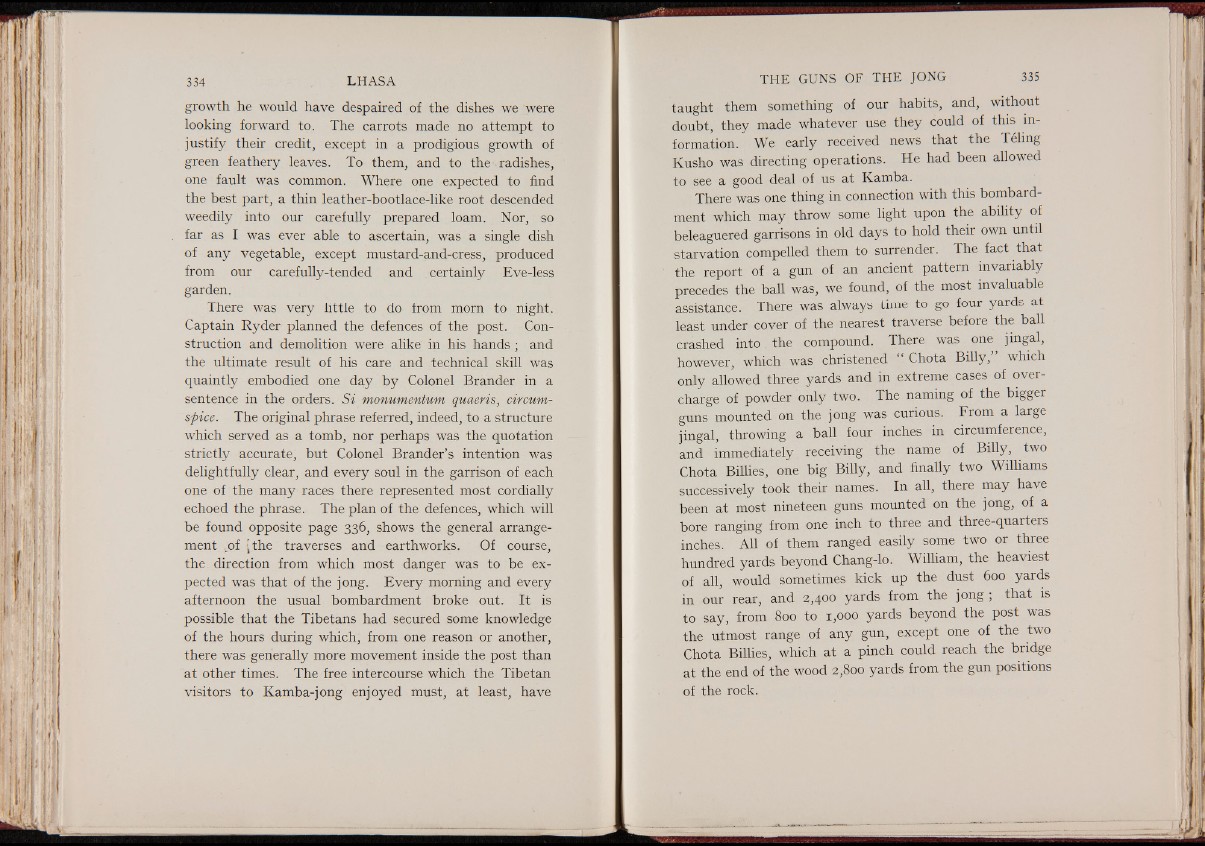
growth he would have despaired of the dishes we were
looking forward to. The carrots made no attempt to
justify their credit, except in a prodigious growth of
green feathery leaves. To them, and to the radishes,
one fault was common. Where one expected to find
the best part, a thin leather-bootlace-like root descended
weedily into our carefully prepared loam. Nor, so
far as I was ever able to ascertain, was a single dish
of any vegetable, except mustard-and-cress, produced
from our carefully-tended and certainly Eve-less
garden.
There was very little to do from morn to night.
Captain Ryder planned the defences of the post. Construction
and demolition were alike in his hands ; and
the ultimate result of his care and technical skill was
quaintly embodied one day by Colonel Brander in a
sentence in the orders. Si monumentum quaeris, circum-
sftice. The original phrase referred, indeed, to a structure
which served as a tomb, nor perhaps was the quotation
strictly accurate, but Colonel Brander’s intention was
delightfully clear, and every soul in the garrison of each
one of the many races there represented most cordially
echoed the phrase. The plan of the defences, which will
be found opposite page 336, shows the general arrangement
.of [the traverses and earthworks. Of course,
the. direction from which most danger was to be expected
was that of the jong. Every morning and every
afternoon the usual bombardment broke out. It is
possible that the Tibetans had secured some knowledge
of the hours during which, from one reason or another,
there was generally more movement inside the post than
at other times. The free intercourse which the Tibetan
visitors to Kamba-jong enjoyed must, at least, have
taught them something of our habits, and, without
doubt, they made whatever use they could of this information.
We early received news that the Teling
Kusho was directing operations. He had been allowed
to see a good deal of us at Kamba.
There was one thing in connection with this bombardment
which may throw some light upon the ability of
beleaguered garrisons in old days to hold their own until
starvation compelled them to surrender. The fact that
the report of a gun of an ancient pattern invariably
precedes the bah was, we found, of the most invaluable
assistance. There was always time to go four yards at
least under cover of the nearest traverse before the ball
crashed in to . the compound. There was one jingal,
however, which was christened “ Chota Billy,” which
only allowed three yards and in extreme cases of overcharge
of powder only two. The naming of the bigger
guns mounted on the jong was curious. From a large
jingal, throwing a ball four inches in circumference,
and immediately receiving the name of Billy, two
Chota Billies, one big Billy, and finally two Williams
successively took their names. In all, there may have
been at most nineteen guns mounted on the jong, of a
bore ranging from one inch to three and three-quarters
inches. All of them ranged easily some two or three
hundred yards beyond Chang-lo. William, the heaviest
of all, would sometimes kick up the dust 600 yards
in our rear, and 2,4°° yards from the jong ; that is
to say, from 800 to 1,000 yards beyond the post was
the utmost range of any gun, except one of the two
Chota Billies, which at a pinch could reach the bridge
at the end of the wood 2,800 yards from the gun positions
of the rock.